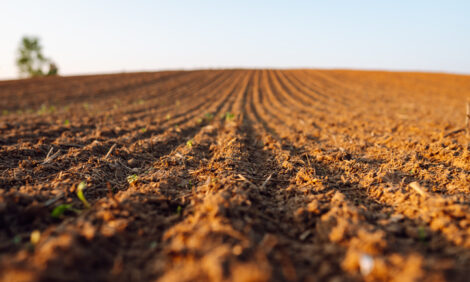



Pork Industry Overview, February 2003: Australia
By USDA, Foreign Agricultural Service - This article provides a summary of pork industry data from the USDA FAS Livestock and Products Semi-Annual 2003 reports for Australia. Links to the full report is also provided. The full report includes all the tabular data which we have omited from the summaries.| Australia - Market Outlook 2003 |
Situation and Outlook
Widespread drought across much of the Australian continent during CY 2002 have completely reversed the previous herd rebuilding phase of the livestock industry. Some areas experienced the second year of drought,
with below average rainfall also recorded in many grazing areas in CY 2001. As a result of the continuing
abnormal climatic conditions, post has revised livestock inventories downward from the previous forecast.
In the Livestock Annual Report (AS 2023, 9/9/2002), cattle inventories were forecast to increase to record levels
and sheep inventories were expected to increase for the first time in a decade due to historically high livestock
prices and increased confidence in livestock industries. However, severe drought and the rapid depletion of
fodder reserves has effectively reversed this trend. Despite severe drought conditions for much of the year,
producers refrained from turning off stock until the final quarter of CY 2002. Until recently, this had effectively
masked the impact of drought.
Post anticipates a return to more normal weather conditions for CY 2003. However, pasture conditions and
fodder reserves would not be expected to return to normal levels until the second half of CY 2003. Higher
slaughter and production levels experienced for the last quarter of CY 2002 are expected to persist for at least
the first half of CY 2003.
Production
Inventory
Post has revised inventory numbers upwards for CY 2001, to 2.7 million head, in line with official
ABS figures. Inventory is estimated to have risen 12 percent to 2.9 million head in CY 2002, unchanged from
post’s previous report. Inventory is forecast to fall six percent, to 2.7 million head, in CY 2003, unchanged from
post’s previous report. A dramatic fall in feedgrain availability and high feedgrain prices due to drought
conditions are expected to put downward pressure on pig numbers for much of CY 2003.
Production (Pig Crop)
Pig crop numbers for CY 2001 remain unchanged from post’s previous report. Post
estimates pig crop numbers for CY 2002 have risen 2.2 percent, to 5.46 million head. Pig crop numbers for CY
2003 are expected to fall two percent, to 5.3 million head. High grain prices and low grain availability have put
downward pressure on inventory numbers (including sow numbers), with post anticipating this will lead to a smaller pig crop for CY 2003.
Slaughter
Official ABS figures place total slaughter for CY 2001 at 5.2 million head, unchanged from post’s
previous report. Slaughter is estimated to have increased nine percent in CY 2002, to over 5.6 million head, the
highest level in over a decade and in line with ABS data for the first nine months of CY 2002. Grain production
in Australia during CY 2002 was more than halved and domestic grain prices have reached record highs forcing
many growers to slaughter stock that otherwise would have been retained.
Slaughter for CY 2003 is forecast to fall slightly, to 5.6 million head, but will remain at historically high levels.
Although post has assumed a return to average weather conditions for CY 2003, post anticipates inventory
numbers to continue to fall until fodder reserves reach more normal levels.
Production
Official ABS production figures for CY 2001 place total pig meat production at 378,488 MT.
Post estimates pig meat production in CY 2002 to rise to 411,000 MT in line with ABS figures for the first nine
months of CY 2002, showing an increase of nearly nine percent. This represents the highest level of production
for over a decade. Increased slaughter, due largely to high feedgrain prices is mostly responsible for the
historically high level of production.
Production is forecast to fall five percent to 390,000 MT in CY 2003. Post anticipates that record feedgrain
prices will cause slaughter weights to fall while keeping slaughter at historically high levels. Although post has
assumed a return to more normal weather conditions, fodder reserves are not expected to return to more normal
levels until the end of CY 2003.
Consumption
Official statistics for overall domestic consumption are not available in Australia. Consumption figures reported by post are derived from imports, exports and production, which post believes are reflective of actual consumption patterns.
Post estimates domestic consumption in CY 2002 to increase nearly six percent, to 381 TMT, the highest level
in over a decade. This increase is being driven by historically high levels of production.
Domestic consumption is forecast to decrease slightly in CY 2003, to 390 TMT. Historically high production
and imports, together with the continual increase in white meat consumption, is expected to keep consumption
at historically high levels
Stocks
Official statistics on stock levels are not available in Australia. Stock levels reported by post are derived from the residual of other categories of data.
The GOA does not have programs to encourage the accumulation of stocks of pigmeat. Post believes that stock levels in Australia are reflective of the commercial environment in which pigmeat is produced.
Trade
Official ABS statistics place exports for CY 2001 at 52.8 TMT in shipped weight. Post believes this figure to be approximately equal to 66 TMT in Carcass Weight Equivalent (CWE) using a conversion factor of 1.25.
Exports are estimated to have increased dramatically to 80 TMT (CWE) in CY 2002. Official ABS data show exports increased by 15 percent for the first nine months of CY 2002. However, the September quarter showed a 22 percent increase in exports versus the previous year. Also, monthly slaughter data for September to November indicate production increases on the order of 22 percent for the final quarter. Post believes increased production is more likely to be exported than consumed domestically.
Exports for CY 2003 are forecast to remain unchanged at 80 TMT CWE from the previous year’s historically high levels.
To view the PDF report and tables (ideal for printing) Click Here
List of Articles in this series
Pork Industry Overview, March 2003: Russian Federation
Pork Industry Overview, February 2003: Canada and Brazil
Pork Industry Overview, February 2003: Korea, Hong Kong, Japan and China
Pork Industry Overview, February 2003: Netherlands and Poland
Pork Industry Overview, February 2003: Australia
Pork Industry Overview, February 2003: European Union
Source: USDA, FAS - International Agricultural Trade Report - February 2003







